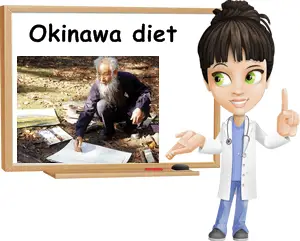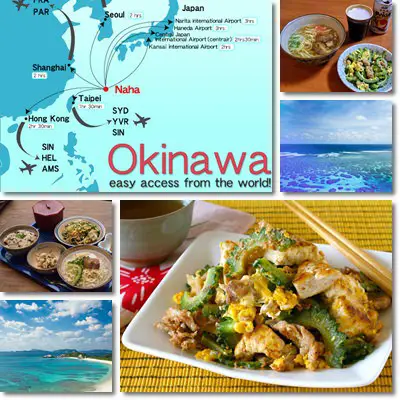The Okinawa diet is an eating and weight-loss plan replicating the eating habits of the inhabitants of the Okinawa islands of Japan. The notoriety of this diet plan is owed to the fact that Okinawans are the most longevous people in the world. The Okinawa diet basically replicates the eating habits of the inhabitants of Japan’s Ryukyu Islands, a large group of islands in the southwest of Japan. Okinawa is the largest, and the most famous of them (in part due to the Karate Kid movie).
Despite being known as the Okinawa diet, this eating plan comprehends the eating habits of all the inhabitants of the Ryukyu Islands. As mentioned above, the Okinawa diet is famous because it is believed to confer longevity to anyone following its guidelines. Studies show that, on average, Japanese people tend to live the longest. But out of all regions of the Japanese archipelago, the inhabitants of the Ryukyu islands of Okinawa have been found to be the most longevous.

Reports dating back only several years ago indicated that Okinawans had an average lifespan of about 110 years. The same studies that observed the longevity of Okinawan people noted that they also appeared to lead a healthy life and a productive lifestyle well into old age. This is because they generally had a lower risk of developing debilitating degenerative or chronic illnesses affecting mobility, cognitive function and so on. At first it was believed that the longevity of the Okinawan people was owed to their genetic makeup.
However, more recent studies suggest that the most important factor influencing longevity in Okinawan people is their diet. As a result of this discovery, the Okinawan diet has become a gold standard of nutrition, health and wellness. While living conditions, climate, stress levels, environmental factors, food, water and air quality as well as the origin of foods, soil quality, pesticide use for food production and so on all impact health and longevity, the Okinawan diet appears to bear forth great health benefits.
Okinawa diet nutrition facts and more
Find out what are the 6 key-facts about the Okinawa diet:
Goya chanpuru
Goya chanpuru is the most popular dish in Okinawa cuisine. It contains stir-fried sliced goya (bitter melon, Momordica charantia), tofu, eggs, sweet potatoes, pork slices, (quail or chicken) eggs, onions, even goat meat or fresh fish.
See what are the benefits of bitter melon.

Yagisashi
Okinawan cuisine greatly encourages the consumption of goat meat, milk and cheese. Yagisashi is a dish referring to very thin raw goat meat slices served with lemon juice.
Low-calorie diet
The average Japanese enjoys an overall low-calorie diet compared to that of other nations where the tendency is to eat more than required. Okinawans however are estimated to eat 20% less calories than the average Japanese and have an average BMI of 20. A BMI of 20 translates into a healthy weight, a lean body and little body fat. It also means a lower overall risk of chronic illness (cancer, diabetes, heart disease), increased fertility and better sleep.
High-antioxidant diet
The Okinawa diet is extremely rich in antioxidants. The reason for this is because almost 3/4 of what the islanders eat is made up of fresh fruits and vegetables. It has been noted that Okinawans consume great amounts of yellow, orange and green fruits and vegetables and thus have a high intake of vitamins C, A and K, flavonoid polyphenolic compounds such as beta-carotene, lutein and other xanthophylls and carotenes, xanthins and minerals such as calcium, iron, zinc, potassium and manganese, all of which exhibit powerful antioxidant properties.
Low sugar and fat intake
First of all, Okinawans do no generally consume processed foods with high amounts of refined sugar and unhealthy fats. Secondly, despite the fact that they eat pork, goat and goat cheese, they do so with moderation so they have an overall low-fat diet.
Fruits, vegetables and fish
The traditional Okinawa diet is an almost vegetarian diet. It focuses on an increased intake of GOY (green, orange and yellow) fruits and vegetables, roots and legumes and a moderate to low intake of fish. While fruits and vegetables provide a rich source of antioxidants, fish provide essential fatty acids such as Omega-3, excellent for cardiovascular health. Quail eggs too provide good amounts of Omega-3 fatty acids (see the benefits of quail eggs). At the same time, the Okinawa diet encourages the consumption of low amounts of legumes and tofu, a soy product thought to offer cardiovascular benefits and anti-cancer protection.
Considerations
Overall, the Okinawan dietary practices comprised by the Okinawa diet are an ideal eating plan, moreso for a Japanese setting. However, as a result of the US influence in the Okinawa island, native dietary practices have begun to shift from a healthy, almost vegetarian, low-fat diet to a more commercial diet starting with the 1960s. The sweet potato, which once represented almost 70% of an Okinawan’s daily food intake, is now being substituted by rice and bread. Fat intake has also increased to almost 30% of total calories.
The traditional Okinawan way of eating has begun losing ground, thus marking the decline of a tradition dating back to the 1600s. With dietary practices shifting towards a more global diet, the number of Okinawan centenarians has started to decline, with figures becoming more visible in male centenarians. Nevertheless, Japan still holds the record for most centenarians, upholding the standard of living represented by the Okinawa diet.
